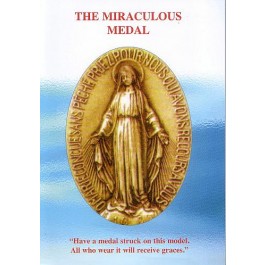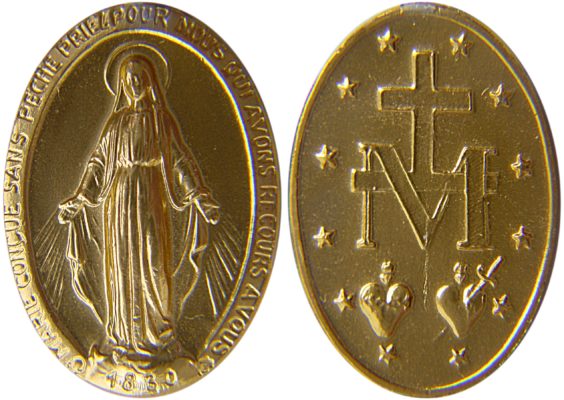 Mary’s Design Symbolizes Key Elements of the Catholic Faith
Mary’s Design Symbolizes Key Elements of the Catholic Faith
November 27 marks the 186th anniversary of the Medal of the Immaculate Conception, popularly known by Catholics the world over as the Miraculous Medal. The Miraculous Medal has a special place in the hearts of the Marian Fathers of the Immaculate Conception, since it paved the way for the Church’s official declaration of the dogma in 1854.
The medal is striking because Our Lady herself presented the familiar design.
The front of the medal depicts Mary standing on a globe, with the head of a serpent beneath her feet. Circling the oval-shaped medal is the signature, “O Mary, conceived without sin, pray for us who have recourse to thee.” On the reverse, 12 stars surround a large “M,” from which a cross arises. Below the “M,” the medal depicts two flaming hearts. The left heart, circled with thorns, represents Jesus. The right heart, pierced by a sword, symbolizes Mary.
An Unlikely Helper
By what intervention and through what vessel did the Blessed Mother convey the design of this medal? As in the case of the Divine Mercy revelations of St. Faustina, a young, unassuming nun in 1930s Poland, once again God chose an unlikely helper. Nearly 100 years earlier, He selected a 24-year-old novice in the community of Sisters known as the Daughters of Charity, Paris, France, in 1830.
The extraordinary story begins on the night of July 18, 1830, when a mysterious child awakens Sr. Catherine Laboure. The child leads her to the convent’s chapel. There, Sr. Catherine sees the Virgin Mary sitting in a chair. She kneels beside Mary and rests her hands in the Virgin’s lap. The two speak for several hours. During the conversation, Mary promises she will return and give the young nun “a mission.” The child leads Catherine back to her bed. Catherine hears the clock strike 2 a.m., July 19.
A little more than four months later, Sr. Catherine learns what Mary wants.
During her evening meditation on Nov. 27, 1830, Catherine has a vision of Mary standing in a position similar to the depiction on the medal. Later, the vision changes to include the inscription found on the front side of the medal.
Mary speaks to Catherine, saying, “Have a medal struck upon this model. Those who wear it will receive great graces, especially if they wear it around their neck.”
It was as Mary said. The medal’s effects were immediate.
Iconic Attraction
The first medals were made in 1832 and distributed throughout Paris. According to the Association of the Miraculous Medal, the blessings that Mary promised “began to shower down” on wearers of the medal. The devotion spread rapidly. In 1836, a Church investigation declared the apparitions to be genuine.
Since Mary asked Catherine to have the medal struck, devotion to the Miraculous Medal has spread the world over, the image having achieved iconic stature.
But what does the medal mean? In answering that, one discovers why it works.

The Front Side
• Mary stands on a globe, crushing a serpent beneath her feet. Describing the original vision, Catherine said the Blessed Mother appeared radiant as a sunrise, “in all her perfect beauty.”
• Rays shoot out from Mary’s hands, which she told Catherine, “… symbolize the graces I shed upon those who ask for them.”
• Words from the vision form an oval frame around Mary: “O Mary, conceived without sin, pray for us who have recourse to thee.”
Seen as a matrix, the elements of the front design encapsulate major Marian tenets:
Quality of Our Lady As Illustrated by the Medal
• Mother — Her open arms, the “recourse” we have in her.
• Immaculate — The words, “conceived without sin.”
• Assumed into Heaven — She stands on the globe.
• Mediatrix — Rays from her hands symbolizing “graces.”
• Our Protection — Crushes the serpent (Gn 3:15).
The Reverse Side
• A cross-and-bar surmounts a large, bold “M.”
• 12 stars disperse around the perimeter.
• Two hearts are depicted underneath the “M,” the left lapped with a crown of thorns, the right skewed by a sword. From each, a flame emanates from the top. Again, employing a grid analysis, we can see how the reverse-side design contains great symbolism reflecting major tenets of the Catholic faith.
Design Element and its Catholic Meaning
• The large letter “M” — Mary as Mother, Mediatrix.
• Cross and bar — Jesus’ Cross of Redemption.
• 12 stars — 12 Apostles, who formed the first Church.
• Left Heart — The Sacred Heart, who died for our sins.
• Right Heart — The Immaculate Heart, who intercedes for us.
• Flames — The burning love Jesus and Mary have for us.
The Association of the Miraculous Medal in Perryville, Missouri, notes that there is no superstition or magic connected with the Miraculous Medal, nor is it “a good luck charm.” Rather, it is “a testimony to faith and the power of trusting prayer. Its greatest miracles are those of patience, forgiveness, repentance, and faith.”
Source: DivineMercy
